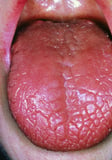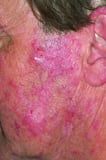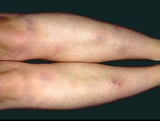Isit Easy to Tell the Difference of a Salivary Stone to a Salivary Tumor
Salivary glands produce saliva, which moistens food to make it easy to swallow and contains enzymes (proteins) to help break down food so it is easier to digest.
-
Salivary glands can malfunction, become infected, or blocked by stones that form in their ducts.
-
Malfunctioning salivary glands produce less saliva, which causes dry mouth and tooth decay.
-
Infected or blocked salivary glands cause pain.
-
Saliva flow can be measured, or doctors may biopsy salivary gland tissue.
-
Sometimes blockages in the ducts that lead from the salivary glands can be removed, but some people need to use saliva substitutes.
There are three major pairs of salivary glands in the mouth:
-
The parotid glands, the largest pair of salivary glands, lie just behind the angle of the jaw, below and in front of the ears.
-
The sublingual glands lie under the side of the tongue.
-
The submandibular glands lie under the side of the jaw.
In addition to these major glands, many tiny salivary glands are distributed throughout the mouth. All of the glands produce saliva, which aids in breaking down food as part of the digestive process.
Locating the Major Salivary Glands
Several types of disorders affect the salivary glands:
-
Salivary gland malfunction
-
Salivary gland stones
-
Salivary gland infection
-
Salivary gland swelling
Certain conditions can decrease saliva production:
-
Diseases, such as Sjögren syndrome Sjögren Syndrome Sjögren syndrome is a common autoimmune rheumatic disorder and is characterized by excessive dryness of the eyes, mouth, and other mucous membranes. White blood cells can infiltrate and damage... read more
 , rheumatoid arthritis Rheumatoid Arthritis (RA) Rheumatoid arthritis is an inflammatory arthritis in which joints, usually including those of the hands and feet, are inflamed, resulting in swelling, pain, and often destruction of joints.... read more
, rheumatoid arthritis Rheumatoid Arthritis (RA) Rheumatoid arthritis is an inflammatory arthritis in which joints, usually including those of the hands and feet, are inflamed, resulting in swelling, pain, and often destruction of joints.... read more  , and lupus Systemic Lupus Erythematosus (SLE) Systemic lupus erythematosus is a chronic autoimmune inflammatory connective tissue disorder that can involve joints, kidneys, skin, mucous membranes, and blood vessel walls. Problems in the... read more
, and lupus Systemic Lupus Erythematosus (SLE) Systemic lupus erythematosus is a chronic autoimmune inflammatory connective tissue disorder that can involve joints, kidneys, skin, mucous membranes, and blood vessel walls. Problems in the... read more  (systemic lupus erythematosus)
(systemic lupus erythematosus) -
Drugs, such as certain antidepressants, antihistamines, antipsychotics, anti-Parkinson drugs, sedatives, methyldopa, diuretics, and illegal methamphetamine
-
Chemotherapy or head and neck radiation for the treatment of cancer, or radioactive iodine for the treatment of thyroid cancer
Dry mouth due to radiation is usually permanent, especially if the radiation dose is high. Dry mouth due to chemotherapy is usually temporary.
However, not all cases of dry mouth are caused by salivary gland malfunction. For example, dry mouth may be caused by
-
Drinking too little liquid
-
Breathing through the mouth
-
Anxiety or stress
The mouth may also dry somewhat as a person ages, although in such cases, drying is more often caused by taking a drug that causes dry mouth than by the aging process itself.
In rare cases, the salivary glands produce too much saliva. Increased saliva production is usually very brief and occurs in response to eating certain foods, such as sour foods. Sometimes even thinking about eating these foods can increase saliva production.
Salivary stones create problems when they block the tube (duct) that carries saliva from the gland to the mouth. Blockage makes saliva back up inside the duct, causing the salivary gland to swell painfully. A blocked duct and gland filled with stagnant saliva may become infected with bacteria.
A typical symptom of a blocked salivary duct is swelling and pain over the gland that is affected. The pain and swelling worsen after eating, particularly when people eat something that stimulates saliva flow (such as a pickle or lemon juice) because when the duct is blocked, the saliva has no place to go and the gland swells. The swelling may go down after a few hours, and the duct may release a gush of saliva. Some stones do not cause any symptoms.
Salivary gland infection is also called sialadenitis. Most salivary gland infections occur in people who have something that blocks the flow of saliva (such as a stone) or who have very low flow of saliva. Infection is most common in the parotid gland and typically occurs in people who
-
Are in their 50s and 60s
-
Have a chronic illness and dry mouth
-
Have had radiation therapy to the mouth area or radioactive iodine therapy for thyroid cancer
People with a bacterial infection of a salivary gland have fever, chills, and pain and swelling on the side of the face with the infected gland. The skin over the infected gland becomes red and swollen. Sometimes a collection of pus (abscess) forms in the gland, and a small amount of pus comes out of the duct of the gland.
Childhood mumps Mumps Mumps is a contagious viral infection that causes painful enlargement of the salivary glands. The infection may also affect the testes, brain, and pancreas, especially in adults. Mumps is caused... read more  , certain bacterial infections (for example, of the tonsils or teeth), and other diseases that are typically more common among adults (such as AIDS Human Immunodeficiency Virus (HIV) Infection Human immunodeficiency virus (HIV) infection is a viral infection that progressively destroys certain white blood cells and can cause acquired immunodeficiency syndrome (AIDS). HIV is transmitted... read more
, certain bacterial infections (for example, of the tonsils or teeth), and other diseases that are typically more common among adults (such as AIDS Human Immunodeficiency Virus (HIV) Infection Human immunodeficiency virus (HIV) infection is a viral infection that progressively destroys certain white blood cells and can cause acquired immunodeficiency syndrome (AIDS). HIV is transmitted... read more  , Sjögren syndrome Sjögren Syndrome Sjögren syndrome is a common autoimmune rheumatic disorder and is characterized by excessive dryness of the eyes, mouth, and other mucous membranes. White blood cells can infiltrate and damage... read more
, Sjögren syndrome Sjögren Syndrome Sjögren syndrome is a common autoimmune rheumatic disorder and is characterized by excessive dryness of the eyes, mouth, and other mucous membranes. White blood cells can infiltrate and damage... read more  , diabetes mellitus Diabetes Mellitus (DM) Diabetes mellitus is a disorder in which the body does not produce enough or respond normally to insulin, causing blood sugar (glucose) levels to be abnormally high. Urination and thirst are... read more , sarcoidosis Sarcoidosis Sarcoidosis is a disease in which abnormal collections of inflammatory cells (granulomas) form in many organs of the body. Sarcoidosis usually develops in people aged 20 to 40, most often people... read more
, diabetes mellitus Diabetes Mellitus (DM) Diabetes mellitus is a disorder in which the body does not produce enough or respond normally to insulin, causing blood sugar (glucose) levels to be abnormally high. Urination and thirst are... read more , sarcoidosis Sarcoidosis Sarcoidosis is a disease in which abnormal collections of inflammatory cells (granulomas) form in many organs of the body. Sarcoidosis usually develops in people aged 20 to 40, most often people... read more  , and bulimia Bulimia Nervosa Bulimia nervosa is an eating disorder characterized by the repeated rapid consumption of large amounts of food (binge eating), followed by attempts to compensate for the excess food consumed... read more ) often cause swelling of the major salivary glands.
, and bulimia Bulimia Nervosa Bulimia nervosa is an eating disorder characterized by the repeated rapid consumption of large amounts of food (binge eating), followed by attempts to compensate for the excess food consumed... read more ) often cause swelling of the major salivary glands.
An injury to the lower lip—for instance, from accidental biting—may harm any of the minor salivary glands found there and block the flow of saliva. As a result, an affected gland may swell and form a small, soft lump (mucocele) that appears bluish. The lump usually disappears by itself within a few weeks to months.
-
Biopsy
-
Endoscopy
-
Imaging studies
-
For infection, culture of pus from the salivary gland duct
There are no good tests to measure saliva production. However, the salivary glands can be squeezed (milked), and the ducts can be observed for saliva flow.
Swelling due to blockage of a salivary duct is diagnosed because of the relationship of pain to eating or drinking something that stimulates saliva flow. To diagnose other causes of swelling, a dentist or doctor may do a biopsy to obtain a sample of salivary gland tissue and examine it under a microscope. Other causes of blockage may be identified by newer techniques that use very small viewing tubes (endoscopes) that can be inserted into the salivary gland ducts.
If doctors are not able to make the diagnosis during the physical examination, they may do certain imaging studies, such as computed tomography (CT), ultrasonography, and sialography. Sialography is a type of x-ray that is taken after a dye that is visible on x-rays has been injected into the salivary glands and ducts.
If infection is suspected, doctors look for inflammation on imaging tests, such as a computed tomography (CT) scan, ultrasonography, or magnetic resonance imaging (MRI). If the doctor can squeeze pus from the duct of the affected gland, it is cultured (sent to the laboratory to try to grow bacteria).
-
For dry mouth, good dental hygiene and sometimes drugs
-
For stones, pain relievers, fluids, physical measures, or sometimes removal
-
For infection, antibiotics and physical measures
-
For swelling, various treatments, possibly including surgery
For dry mouth, people should
-
Avoid drugs that decrease saliva production
-
Sip fluids throughout the day
-
Brush and floss regularly
-
Use fluoride rinses
-
Visit their dentist for examination and cleaning every 3 to 4 months
-
Sometimes a saliva substitute containing carboxymethylcellulose as a mouthwash
-
Sometimes chew sugarless gum or suck on xylitol lozenges
Some dentists have people wear plastic tooth covers filled with fluoride gel at night to prevent tooth decay due to dry mouth. Sometimes, drugs that increase saliva production, such as cevimeline or pilocarpine, help relieve symptoms. Such drugs may not help when the salivary glands have been damaged by radiation.
For salivary gland stones, people can take pain relievers (analgesics), drink extra fluids, massage the glands, apply warm compresses, and trigger saliva flow with lemon juice or wedges, sour candy, or a combination. If the stone does not pass on its own, a dentist can sometimes push the stone out by pressing on both sides of the duct. If that fails, a fine-wire‒like instrument can be used to pull out the stone. As a last resort, the stone can be removed surgically or through an endoscope.
For salivary gland infection, doctors give antibiotics and have people massage the glands and apply warm compresses. A salivary abscess needs to be cut open and drained. Staying hydrated, triggering saliva with lemon juice and hard candies, and having good oral hygiene are also important.
Salivary gland swelling treatment varies with the cause. A mucocele that does not disappear on its own can be removed surgically if it becomes bothersome. Similarly, both noncancerous and cancerous salivary gland tumors can usually be removed surgically.
Source: https://www.msdmanuals.com/home/ear,-nose,-and-throat-disorders/mouth-and-throat-disorders/salivary-gland-disorders
0 Response to "Isit Easy to Tell the Difference of a Salivary Stone to a Salivary Tumor"
Post a Comment